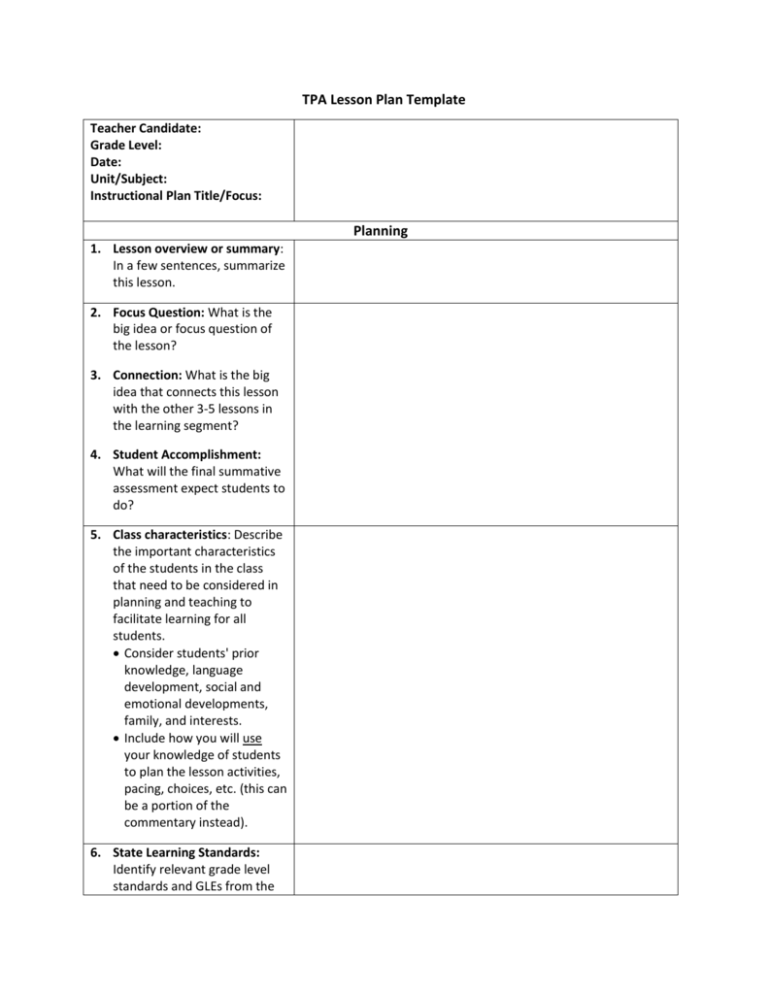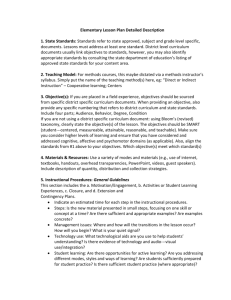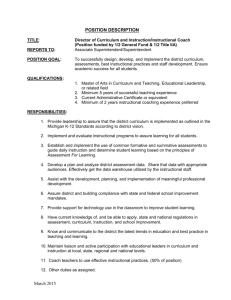TPA Lesson Plan Template
advertisement

TPA Lesson Plan Template Teacher Candidate: Grade Level: Date: Unit/Subject: Instructional Plan Title/Focus: Planning 1. Lesson overview or summary: In a few sentences, summarize this lesson. 2. Focus Question: What is the big idea or focus question of the lesson? 3. Connection: What is the big idea that connects this lesson with the other 3-5 lessons in the learning segment? 4. Student Accomplishment: What will the final summative assessment expect students to do? 5. Class characteristics: Describe the important characteristics of the students in the class that need to be considered in planning and teaching to facilitate learning for all students. Consider students' prior knowledge, language development, social and emotional developments, family, and interests. Include how you will use your knowledge of students to plan the lesson activities, pacing, choices, etc. (this can be a portion of the commentary instead). 6. State Learning Standards: Identify relevant grade level standards and GLEs from the WA State Content Learning Standards, Common Core Standards, NETS*S, PEs, and/or CBA in a format that clearly identifies subject and GLE/standard. 7. Learning Targets: What should the students know or be able to do after the instruction? Use a common format with a measurable verb that matches the cognitive domain of the standard/GLE (see #11 below). Consider including language targets as well. 8. Academic Language: List the academic language/ language demands for the lesson (consider both form and function). 9. Key Vocabulary: List the key content vocabulary that will be covered. 10. Grouping: Describe how and why students will be divided into groups, if applicable (random, ability, interest, social purposes, etc.). Assessment 11. Assessment Strategies Attach questions, worksheets, tests or any additional documentation related to your assessment strategies. Also attach appropriate marking rubrics, criteria lists, expectations, answer keys, etc. • Formative: measures process/progress toward mastery of target(s) • Summative: measures outcomes/achievement of target(s) Target-Assessment Alignment Table Learning Targets Write a learning target here from #6. Assessment Strategies Formative: In this space, tell how you will assess (F&S) whether students have met this target. Summative: Use a new cell for each target you are asking students to meet in this lesson. Formative: Summative: Learning/Teaching Experiences: 12. Introduction: Identify how you are going to introduce the concept, skill or task in a way that gains students’ attention and gets them involved. How will this lesson be meaningful to the students and connect to their lives. Connect this lesson to previous lessons/ learning (prior knowledge of students) and students’ lives. How is this introduction built off of your knowledge of these students? 13. Learning Activities: Give detailed, step-by-step instructions on how you will implement the instructional plan. Describe exactly what students will do during the lesson. Please use a numbered list. In planning your lesson, think about: transition statements you make throughout your lesson and write them out write down the questions you want to ask use note cards to guide you through the lesson set up your lesson in two columns I Do Students Do 14. Teaching Strategies: a. Instructional procedures: List the teaching approaches or modes you will use to teach each step (such as ppt, demonstrate example, graphics, partner practice, etc.). b. Multiple means of access: List ways the teacher will present the materials. c. Multiple means of engagement: List ways the students will participate in the learning. d. Multiple means of expression: List ways the students can show their learning. (a. through h. on left are prompts to help you plan your lesson. You should figure these out first, then do your lesson #13 above.) e. Methods of differentiation: List accommodation or differentiation strategies. f. Language learning objectives: Where will you integrate these? g. Remedial activities: List a review sheet, scaffolding worksheet or plan. h. Extension activities: What will students who finish early do? 15. Closure: Explain how you are going to bring closure to the lesson. a. Explain how students will share what they have learned in the lesson. (Identify 2 questions that you can ask students to begin the conversation. ) b. Describe how you will connect this content to students’ lives and to future lessons. 16. Independent Practice: Describe how students will extend their experiences with the content and demonstrate understanding beyond the scope of the lesson outside the class. Student Voice: Identify how students will reflect and/or communicate on their learning or progress toward meeting the goals (see chart below). K-12 students will do the following: 1 Communicate the learning targets and explains in their own words why they are important to them. Student-based evidence to be collected (things produced by students: journals, work samples, projects, papers, etc.) Description of how students will reflect on their learning. 2 Identify what they are doing well and what they need to improve. 3 Identify what materials or resources they need to support their progress toward the target 17. Reflection on Student Learning: Reflect on the lesson, assessments and on the student voice evidence to identify changes and general instructional implications. 18. Next Steps: Based on the above, what you will do in your next lesson to ensure students' learning. 19. Instructional Materials, Equipment and Technology: Attach a copy of ALL materials the teacher and students will use during the lesson; e.g., handouts, questions to answer, overheads, PowerPoint slides, worksheets. List equipment or technology that needs to be available. 20. Additional Requirements a. Acknowledgements: Acknowledge your sources. Give credit to the person who created the idea for the instructional plan, including yourself. You might use language such as "Instructional Plan adapted from _____”; “Instructional Plan Consultants (not responsible for the content of this instructional plan): _______”; and/or “Instructional Plan Created by _____” Cite scripted materials/curriculum if appropriate. b. References: List in APA format references for both learning strategies and content.






